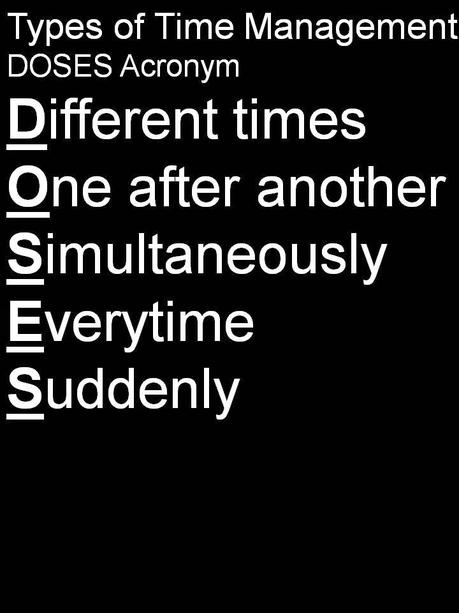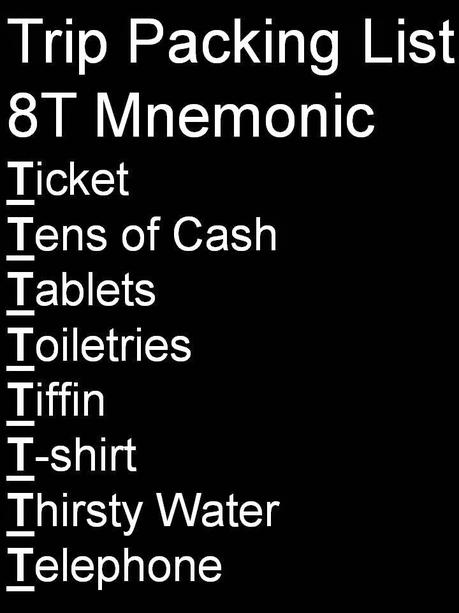Goals
Organization
Technology Management
Sustainable living
Thinking
Information Management
Learning
1. Personal Goal Setting
1.1 Risk Management
Assessing the risk before, during and after an event and identifying the possibilities, probabilities and pinch (Impact). The impact can be low, medium and high and after the event you can either reverse or repair the change.1.2 Delegation
After we delegate, we either micro or macro manage. While delegating, people learn in two different ways, I See/ I Do, You See/You do. People learn bit by bit/Whole, Give time/limited time. People learn quickly/retain longer or slowly/retain shorter.2. Personal Organization
2.1 Time Management
Time management includes planning, multitasking, organizing and prioritizing. It is one of the influencing skills and it can be memorized using a simple acronym DOSES
Creative Time Management Habits Tips
Different Types of Time Management
Time management can broadly divided into 5 types:- Different times
- One after another
- Simultaneously
- Everytime (frequently)
- Suddenly (unexpected)
Different times: We do various tasks at different times. for example, some of our chore time is household activities, office work, vacation, meeting friends and relative, spending time alone are some of the examples of different times. You can plan these activities in order to manage time.
Prioritizing time Chronologically, One after Another: Organizing is subset of planning. After you plan you organize these activities one after another to manage time effectively and efficiently.
For example, you can organize your regular household activities on a weekend. You say to yourself, " this Saturday, I would first go to supermarket, pick vegetables and fruits, and then go to apparel shop, buy shirts and sweaters, and finally, in the evening, I will meet my relative and come back home".
Doing All Tasks at a Time is Multitasking: A very simple example of multitasking is driving a car. While driving, you do so many things at a time, steer, apply clutch, changing gears, accelerate while steering and so on. Multitasking requires practice and focus.
Organizing time based on its frequency (every-time): There are several tasks that differs in its frequency. Few everyday examples includes paying your electricity bills, mobile bills, renewing your license and insurance policies. Organize them in your to do list, prioritize them as per the expiry date to manage time.
Forecasting your Sudden Unexpected Tasks: Especially at workplace, an unforeseen task is quite common. These tasks are unexpected but sits in the priority list of the work schedule. Therefore, many business professionals are quite smart and they dedicate a buffer time to compensate the unanticipated task or forecast it proactively.
For example, a good manager always sets aside 2 extra days to deliver an office project so that last minute tasks, changes and corrections could be accommodated in this buffer time.
When you are conscious about how you spend your time, you can influence it, manage it and control it. This simple acronym DOSES can come handy if you'd like to recall some of the types of time management.
2.2 (Things) A Smart Traveller Knows What to Pack-Uses Simple T Words Mnemonic Devices

Travel Packing Organization Checklist Habits Examples
"What to pack?" is one question almost all travelers ask before planning. A smart traveler would memorize "T Words", an easy to recall mnemonic device, to remember the packlist. Both an occasional traveler, who travels once in a year, and frequent traveler, who tours round the clock, would benefit from this simple T mnemonic device. A Traveler can be rest assured that all the necessary stuff has been taken for a peaceful travel once they memorize these words that start with t. This mnemonic is ideal of weekend trips, road trips, business trips, overnight trips, school trips, motorcycle trips, ski trips and backpacking trips.Before packing suitcase, take travel advice; The eight T words summarizes trip packing list that can make any travel organized:-
Tickets: Tickets include both to and fro journey. Tickets also hints gift vouchers and travel discount coupons.
Tag (Card): Tags include all cards that you tag; office identification card, credit cards, debit cards, visiting cards and so on. Most business firms have strict regulations and insist their employees to bring their office IDs and swipe them before entering the office.
Type in Key: The tendency to forget the keys is quite common. Organized office executives buy carry bags to keep their car keys, office drawer keys, cabinet keys, and meeting room keys. It is also a good idea to keep duplicate keys so that it comes handy during emergency situations.
Tens of cash: Here, it is also a clue to remind debit cards, credit cards and currencies during a trip or a vacation. After the invention of credit and debit cards, carrying hard cast is one thing that is often forgotten while leaving to work. Sufficient denominations of currency is required especially for working executives who commute by pubic transport or city taxis.
Tablets: Besides first-aid kit, a frequent traveler must remember to take those medicines. Tablets also include lip guards and sunscreen lotions.
Toiletries: Toiletries include shaving blades, shaving creams, toothpastes, tooth brushes, perfumes, deodorants and soaps.
Carry Handkerchief!
On one hand, a business executive carrying a kerchief shows his/her care towards the environment as they cut down their tissue paper consumption and save paper. While on the hand, these business executives are saved from some of the involuntary human behaviors such as cough, sneeze, yawn, and hiccups.
Tiffin: Food is too expensive, especially at aerodromes and railway stations. Tiffin and tea-biscuit
T-shirt: All these words that start with T, is good to keep while traveling, Though towels and napkins are, sometimes, provided in many lodges.
Thirst: Thirsty water for a Cool Smart Traveler:
This word beginning with t also includes other liquid such as cool drinks and beverages.
Telephone: Many travelers are smart enough to remind themselves to include cell phones in their packlist but often forget to carry the cell charger along. So, this T word should also remind a smart traveler to take the charger (tcharger)
Cell phones as become a necessity rather than a luxury. In fact many business professionals like sales people, business development associates, managers and leaders rely on this magical instrument; cell phone. Also, it is good to remember and set the profile mode, such as silent, discreet or normal, according to the business situations.
Remembering things is the greatest gift of human kind mnemonic devices-commonly known as mnemonics--not only help us to carry knowledge along with us but also makes us recall the necessary information in less than a fraction of a second. And t words is one such mnemonic devices examples that reminds what to pack before traveling.
So, wherever the destination be and whatever the task is, when it comes to remembering things mnemonic devices would be one of the best friends a smart traveler can count on-words that start with T that reminds the trip packing list in a jiffy.
3. Managing Technology

Professional Telephone Etiquette Tips Examples
Effective soft skills and behavioral skills are the two essentials while having any business telephone communication. Soft skills is a reflection of your intrapersonal and interpersonal attitude, is the way your present and interact; While behavioral skills is the way you behave that includes planning, organizing and managing the tasks, time and things. 8P is simple mnemonic that will help to recall some of the important telephone etiquette tips for every business professional.8P mnemonic summarizes the list of tips that stands for:
- Plan and Prepare: With patience, sketch your call before picking up the telephone receiver: 1.Have I noted down all the points that needs to be spoken? 2.Do I have all the supporting details of the call?
- Place: Put down your conversation through words, diagrams, flowcharts and sketches. The more innovative you are the better you this instrument. Pen!
- Pen and Paper: You would save anywhere between 15-50 seconds when you keep a paper or a notepad handy before the call. It serves not only as a reference but makes you recall even after the call end so that you can reflect on the conversation. In fact, having a pen and a paper handy, and choosing the right place before making a call is one to the basics of telephone interview etiquette for all job seekers.
- Place: If you are taking a professional business call, it is always appropriate to choose a silent meeting room than a crowded noisy cubicle. Remember, choosing a right place, during a telephonic conversation, not only enhances the quality of the call but also creates an atmosphere of trust for the receiver.
- Present: Ideally, every phone call should have an effective introduction that start with--A good greeting, good morning, good afternoon, thanks for calling etc..,--A clear introduction of name, company.--A chronological order of education and experience.
- Pleasant: One basic human value is being courteous. You can bring courteousness through your Tone of voice, or by choosing polite and kind words and phrases such as please, thank you, you're welcome, I can understand that, you are kind(genuine) and so on. In addition, you can build rapport by casually talking about your hobbies and interests but with caution.
- Pause: Non-verbal communication is as important as oral communication. Pauses during a telephone conversations are taken for two reasons; One, pauses shows respect and consideration of the receivers' points and encourages the receiver to talk. Two, pauses helps you to recall information and respond appropriately to the questions. Pauses also help each other to reflect and comprehend that has been spoken during telephone conversation. It also shows that you have good listening skills. If you do not know when to take a pause, just genuinely involve your heart into the conversation and you will take natural pauses intuitively and instinctively.
- Put a pleasing end: Whether the call is successful or not, ending the telephone call with same enthusiasm, energy and excitement determines the positive attitude of a person. Words and phrases such as "Thank you for your call", "I really enjoyed the conversation with you", shows the interest and positive acceptance during the telephone conversation. Also replace negative words with positive or neutral words and phrases.
4. Sustainable Living
4.1 Personal Decisions
Personal buying decisions checklist:- Is it a necessity?
- Will I be able to maintain it?
- Do I own it already?
- Is it part of some other product so that I pick it, break it and modify it to my requirement?
- Can I make it on my own (Manufacture)?
- Can I repair the existing alternative?
- Can I borrow it from someone?
- Can I upgrade the existing?
- Can I get a second hand?
- Can I buy part of it?
- Are there any other requirements that I can club, multifunction?
- Are there any offers?
- Buy low quality see whether it is useful and then go for a branded?
After you bought something and it is not useful to you, just sell or scrap it instead of keeping it unused.
